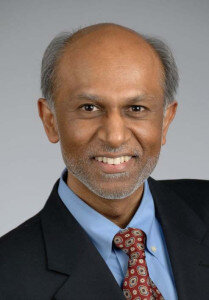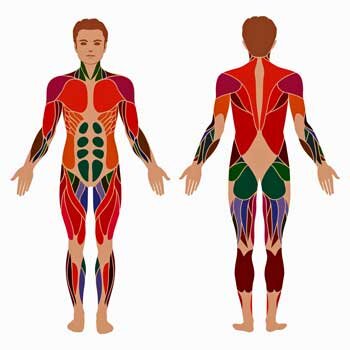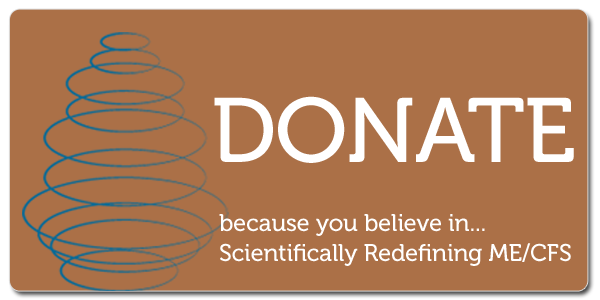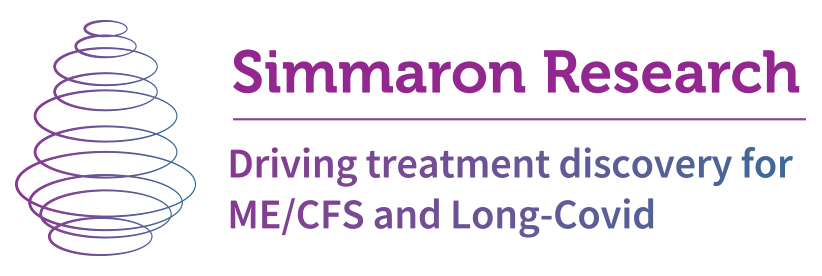Dr Nath Talks on the ME/CFS NIH Intramural Study
It looked like we were going to be late ... again. It was pouring cats and dogs as we eased the van around tangled web of streets that is the NIH campus scanning glumly at the rain-obscured buildings. Even our guide on the phone seemed to be lost.It had been a wild 12 hours. The night before, reaching up to turn on the fan on my brother's porch, I'd let loose a rather large bug which tumbled into my eye. Howling with pain I stumbled off to the bathroom where I managed to wash it out - leaving my eye reddened and swollen. The next morning, my eye still swollen, my partner insisted I see an eye doctor.  To our surprise we found somebody. The problem was was that his office was right in the heart of downtown Washington DC. - where parking is scarce and traffic cops take their jobs very seriously. Finding no parking we stopped in a loading zone across from the doctor's office, hoping that the big yellow van with it's solar panels, Nevada license plate and all would for the next 15 minutes be taken for a loading van -After being assured the appointment would be short, I dashed inside where I was bombarded by frantic calls from my partner (who does not drive the van). She had immediately been accosted by first one then another traffic cop.After seeing the doctor who informed me (for $250 dollars) that insects in the eyes almost never cause problems (but who did give me drops) I dashed back out to the van to find my now none-too happy partner.We sped off in the rain - still seemingly on time for the appointment with Dr. Nath. Hauling up to the NIH we tried no less than three entrances - only to be turned away at each them (our oversize vehicle thwarting one attempt) - and directed to the next. Finally, as our appointment time came and went, we found the right entrance - for, ironically, delivery vehicles.After going through an extensive (and time-consuming) security check we headed off into the labyrinth that is the NIH clutching small hard to decipher maps and immediately got lost. The minutes continued to tick by and rain strengthened into a deluge and eventually we managed to steer onto the right street. Our guide, still on the phone, told us to stop, we jumped out of the car and looked up, rain pouring down, at a steep, muddy climb.Five minutes later - 45 minutes late for our hour appointment, we strode, soaked and bedraggled into Dr. Nath's office. He immediately set us at ease, and with his next appointment running late stayed overtime with us. We were there to talk about the NIH Intramural ME/CFS study.
To our surprise we found somebody. The problem was was that his office was right in the heart of downtown Washington DC. - where parking is scarce and traffic cops take their jobs very seriously. Finding no parking we stopped in a loading zone across from the doctor's office, hoping that the big yellow van with it's solar panels, Nevada license plate and all would for the next 15 minutes be taken for a loading van -After being assured the appointment would be short, I dashed inside where I was bombarded by frantic calls from my partner (who does not drive the van). She had immediately been accosted by first one then another traffic cop.After seeing the doctor who informed me (for $250 dollars) that insects in the eyes almost never cause problems (but who did give me drops) I dashed back out to the van to find my now none-too happy partner.We sped off in the rain - still seemingly on time for the appointment with Dr. Nath. Hauling up to the NIH we tried no less than three entrances - only to be turned away at each them (our oversize vehicle thwarting one attempt) - and directed to the next. Finally, as our appointment time came and went, we found the right entrance - for, ironically, delivery vehicles.After going through an extensive (and time-consuming) security check we headed off into the labyrinth that is the NIH clutching small hard to decipher maps and immediately got lost. The minutes continued to tick by and rain strengthened into a deluge and eventually we managed to steer onto the right street. Our guide, still on the phone, told us to stop, we jumped out of the car and looked up, rain pouring down, at a steep, muddy climb.Five minutes later - 45 minutes late for our hour appointment, we strode, soaked and bedraggled into Dr. Nath's office. He immediately set us at ease, and with his next appointment running late stayed overtime with us. We were there to talk about the NIH Intramural ME/CFS study.
The NIH Intramural ME/CFS Study
Dr. Nath informed us that the applications to be in the NIH Intramural ME/CFS study have been gratifyingly robust. Dr. Nath noted that it was entirely possible that this is the most rigorously examined patient group ever assembled for a study. Dr. Nath is leading the study. He has been around. He received his MD degree from Christian Medical College in India in 1981, completed a residency in Neurology from The University of Texas Health Science Center in Houston, did a fellowship in Multiple Sclerosis and Neurovirology at the same institution, and then another fellowship in Neuro-AIDS at NINDS.Then it was up to Canada, where he held a faculty position at the University of Manitoba (1990-97), and then he was at The University of Kentucky (1997-02). In 2002, he became Professor of Neurology and Director of the Division of Neuroimmunology and Neurological Infections at Johns Hopkins.in 2011, he became the Clinical Director of NINDS, the Director of the Translational Neuroscience Center, and Chief of the Section of Infections of the Nervous System. His research focuses on understanding the pathophysiology of nervous system infections and their outcomes, and the development of new diagnostic and therapeutic approaches for these diseases. He's heavily involved in HIV research, the role endogenous retroviruses play in neurological diseases, and "undiagnosed neuroimmune and neuroinfectious diseases".He recently wrote a paper on Herpes Viruses, Alzheimer's Disease, and Related Dementias: Unifying or Confusing Hypothesis?, which examined what role herpesviruses might be playing in dementia.
Dr. Nath is leading the study. He has been around. He received his MD degree from Christian Medical College in India in 1981, completed a residency in Neurology from The University of Texas Health Science Center in Houston, did a fellowship in Multiple Sclerosis and Neurovirology at the same institution, and then another fellowship in Neuro-AIDS at NINDS.Then it was up to Canada, where he held a faculty position at the University of Manitoba (1990-97), and then he was at The University of Kentucky (1997-02). In 2002, he became Professor of Neurology and Director of the Division of Neuroimmunology and Neurological Infections at Johns Hopkins.in 2011, he became the Clinical Director of NINDS, the Director of the Translational Neuroscience Center, and Chief of the Section of Infections of the Nervous System. His research focuses on understanding the pathophysiology of nervous system infections and their outcomes, and the development of new diagnostic and therapeutic approaches for these diseases. He's heavily involved in HIV research, the role endogenous retroviruses play in neurological diseases, and "undiagnosed neuroimmune and neuroinfectious diseases".He recently wrote a paper on Herpes Viruses, Alzheimer's Disease, and Related Dementias: Unifying or Confusing Hypothesis?, which examined what role herpesviruses might be playing in dementia.
The NIH Intramural Chronic Fatigue Syndrome Study
The study takes place in two parts: a one week part which further assesses the potential participant and another one week section which measures a wide variety of parameters before and after an exercise test.Requirements for entry are high, however, and not often met. You might say that many have been called - or rather have called - but few have been chosen. That was OK with Dr. Nath. "We need," he explained, "to make sure that we're studying the right population. That’s the best way to get to the answer, and then it'll be broadly applicable."The response has been excellent. Many people are traveling to participate, and they're coming from all over. The NIH is even getting interest from people in other countries.As of Dec. last year, 337 people had inquired about the study. One hundred and seventy-three were quickly screened out, and 164 participated in phone interviews. One hundred and twenty-seven made it to the medical record assessment stage.Multiple reasons thwarted would-be participants from participating in the study. The study required onset within 5 years which was triggered by infection. One-third had had the disease for too long, 20% had no evidence of infectious process (doctor's records are required), 9% were too sick to travel, and just 3% were unwilling to have a lumbar puncture. The researchers were surprised at the last two figures. They expected, based on their experience from past studies, much higher percentages of people who were too sick to travel or unwilling to have a lumbar puncture. Dr. Nath well knows how difficult it can be to get people to participate in a study, but that's not a problem here. Calling the numbers "very good", Dr. Nath said the ME/CFS community was clearly "very motivated to participate in the study”.It is not an easy study! It's a two-part, two-week plus study on a population, which studies suggest, has the lowest functionality of any disease. The study includes a lumbar puncture, a maximal exercise test, several nights in a metal box (metabolic chamber), tilt table test, muscle biopsy, brain scans, lengthy neuropsychological tests and scads of blood tests. Every part of you is going to be probed.Plus, you have to provide your entire medical history, get interviewed several times, and then, most likely travel.Dr. Nath said he looked at the study - which is clearly larger and more intensive than most - and said, "who is going to enroll in this study?" Laughing, he joked that, "I wouldn't volunteer on my own study!" He was afraid no one was going to show up! Instead he said the patients were very willing to undergo all the tests and are grateful for it.Recruitment has been good, but as with any study, Dr. Nath said, it was high at first, and now it's tailed off. As of March of this year, 19 ME/CFS patients and 21 healthy controls had completed the first phase of the study, and six people with ME/CFS and 7 controls had completed phase II.Thus far, then, about half the projected participants (n=40 ME/CFS; 40 healthy controls) have gone through the first week of the study and about 15% have completed the entire study.Quite a few people with autoimmune disorders have shown up during the filtering out process. Nath suggested that could be an interesting cohort to study on its own. He's also found quite a bit of head injury and loss of consciousness - which makes MRI and brain scans difficult to assess - and people with seizures and strokes. Interestingly, bnly one person had had a diagnosis of major depression….
The researchers were surprised at the last two figures. They expected, based on their experience from past studies, much higher percentages of people who were too sick to travel or unwilling to have a lumbar puncture. Dr. Nath well knows how difficult it can be to get people to participate in a study, but that's not a problem here. Calling the numbers "very good", Dr. Nath said the ME/CFS community was clearly "very motivated to participate in the study”.It is not an easy study! It's a two-part, two-week plus study on a population, which studies suggest, has the lowest functionality of any disease. The study includes a lumbar puncture, a maximal exercise test, several nights in a metal box (metabolic chamber), tilt table test, muscle biopsy, brain scans, lengthy neuropsychological tests and scads of blood tests. Every part of you is going to be probed.Plus, you have to provide your entire medical history, get interviewed several times, and then, most likely travel.Dr. Nath said he looked at the study - which is clearly larger and more intensive than most - and said, "who is going to enroll in this study?" Laughing, he joked that, "I wouldn't volunteer on my own study!" He was afraid no one was going to show up! Instead he said the patients were very willing to undergo all the tests and are grateful for it.Recruitment has been good, but as with any study, Dr. Nath said, it was high at first, and now it's tailed off. As of March of this year, 19 ME/CFS patients and 21 healthy controls had completed the first phase of the study, and six people with ME/CFS and 7 controls had completed phase II.Thus far, then, about half the projected participants (n=40 ME/CFS; 40 healthy controls) have gone through the first week of the study and about 15% have completed the entire study.Quite a few people with autoimmune disorders have shown up during the filtering out process. Nath suggested that could be an interesting cohort to study on its own. He's also found quite a bit of head injury and loss of consciousness - which makes MRI and brain scans difficult to assess - and people with seizures and strokes. Interestingly, bnly one person had had a diagnosis of major depression….
High Percentage of Rare Diseases
It's a small sample set but it's remarkable how many people participating in the first week were diagnosed with a rare disease. In something of a testament to the thoroughness of the study, almost third of week one participants (6/19) were found to have a rare disorder which the researchers believed was probably causing their symptoms and dismissed from the study. One appeared to have Parkinson's Disease, another a neurological disease and I'm unsure of the others.The study was designed to catch these people. In fact because ME/CFS is something of a wastebasket diagnosis it went to extra lengths to ensure it was really studying ME/CFS. Plus Dr. Nath reported that neurological diseases are inherently hard to diagnose anyway. It is not unusual for people with multiple sclerosis, Parkinson’s, etc to be misdiagnosed with some other disease initially. Plus, the opposite can happen (and has happened in ME/CFS) with some patients being misdiagnosed with M.S. for many years only to find later that they have some other immune disorder.
Big Data
They are gathering lots and lots of data - which brings its own problem. The study includes two different brain scans, blood, saliva, urine and stool samples, exercise data, tilt table data, spinal taps, Seahorse data, metabolic room data, cognitive testing, muscle and skin biopsies, and I'm probably missing some. I asked Nath, how will they able to integrate all this disparate data? Nath agreed that it was a challenge, but noted that that kind of challenge is a pretty common challenge now. Some of the really big Alzheimer's and Parkinson's studies contain thousands of individuals, each of whom has done thousands of tests. Computational biology has become a major part of medical research.Google, not surprisingly, is collaborating with the NIH to create better ways to analyze data. Many of the discoveries in medicine today, Nath said, actually occur as breakthroughs in physics; MRI and CT scans, for example - came from physics.Their general hypothesis is that an infection triggers brain and immune system issues (ranging from persistent immune activation to immune dysregulation) that stay stuck. They don’t believe the nature of the infection is particularly important.Check out a disease Nath believes could prove a model for ME/CFShttp://simmaronresearch.com/2019/04/nath-chronic-fatigue-syndrome-east-african-disease-model/
Nath agreed that it was a challenge, but noted that that kind of challenge is a pretty common challenge now. Some of the really big Alzheimer's and Parkinson's studies contain thousands of individuals, each of whom has done thousands of tests. Computational biology has become a major part of medical research.Google, not surprisingly, is collaborating with the NIH to create better ways to analyze data. Many of the discoveries in medicine today, Nath said, actually occur as breakthroughs in physics; MRI and CT scans, for example - came from physics.Their general hypothesis is that an infection triggers brain and immune system issues (ranging from persistent immune activation to immune dysregulation) that stay stuck. They don’t believe the nature of the infection is particularly important.Check out a disease Nath believes could prove a model for ME/CFShttp://simmaronresearch.com/2019/04/nath-chronic-fatigue-syndrome-east-african-disease-model/
No Preliminary Findings Yet
Nath was unable to give me any preliminary findings. One reason is that they are storing samples so they can run them all at the same time. Another is that, echoing Ron and Mark Davis's thoughts, they don't want to even try to come up with hypotheses yet. They simply want to gather more and more data.Making a conclusion on the basis of small samples is, Nath said, the kiss the death. They will not even try to interpret their findings until about half the study is done.If, when they get to the end of the study, they see trends but don’t quite have a significant result, they'll do sample size calculations to determine how many more patients they'll need to see to get to statistical significance. If the calculation says do another 10 patients, they'll probably expand the study to do 12 more. If the calculation says do another 100 patients, that's too much.They’re preventing another kind of bias by recoding the samples, so the analyst doesn't know which are from patients and which are from controls.
The Study
Brian Vastag's visit raised the issue of mitochondrial problems. Nath believes studying the muscle itself may be more important than assessing mitochondrial problems using the blood, and added muscle biopsies to the study. The muscle biopsies will be tested for DNA analysis, structural issues, and staining for various kinds of cells.The Open Medicine Foundation and Ron Davis apparently believe likewise. They've pumped a million dollars into an ME/CFS Collaborative Research Center at Harvard lead by Ron Tompkins which will focus on figuring out what is going on in the muscles. Because lots of patients have autonomic symptoms, the NIH is doing tilt table tests. Once those turn out positive, Nath said, the next question is why the autonomic nervous system problems are present. They're doing small fiber neuropathy skin tests and examining the heart, peripheral nerves, adrenal glands, and sympathetic nervous system functioning.I asked him if there were any surprises, and there were. As Robert's story will show, the NIH doesn't seem to be prepared for the level of devastation ME/CFS can wreak in a relatively young group of patients.Nath said his personal contact with the patients has led him to develop a real appreciation for the disease. These patients, he said, "are devastated". Whether or not this study finds a cause, the reality, Nath said, is that the lives of the study patients are "totally messed up." Then he made an important point. Seeing the patients in the flesh naturally causes him and other researchers to develop additional empathy for them and "another level of appreciation" for them and their disease.It was clear that just by being there and exposing the researchers and doctors at the NIH to this disease, the participants in the study are making a difference. The lengths to which some patients are going to participate in this study are amply illustrated by Robert's story.
Because lots of patients have autonomic symptoms, the NIH is doing tilt table tests. Once those turn out positive, Nath said, the next question is why the autonomic nervous system problems are present. They're doing small fiber neuropathy skin tests and examining the heart, peripheral nerves, adrenal glands, and sympathetic nervous system functioning.I asked him if there were any surprises, and there were. As Robert's story will show, the NIH doesn't seem to be prepared for the level of devastation ME/CFS can wreak in a relatively young group of patients.Nath said his personal contact with the patients has led him to develop a real appreciation for the disease. These patients, he said, "are devastated". Whether or not this study finds a cause, the reality, Nath said, is that the lives of the study patients are "totally messed up." Then he made an important point. Seeing the patients in the flesh naturally causes him and other researchers to develop additional empathy for them and "another level of appreciation" for them and their disease.It was clear that just by being there and exposing the researchers and doctors at the NIH to this disease, the participants in the study are making a difference. The lengths to which some patients are going to participate in this study are amply illustrated by Robert's story.
Participating in the Study
The NIH needs more participants. If you're interested in helping to further ME/CFS research by participating in the study, check out the study criteria below.All participants must be 18-60 years old and have at least a 7th grade education. People whose ME/CFS started after an episode of infection and who have severe symptoms lasting from 6 months to 5 years are eligible to participate in the study.Find out more here.'A former doctor on his experience going through the NIH's intramural studyhttp://simmaronresearch.com/2019/03/doctor-nih-chronic-fatigue-intramural-study/
